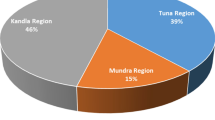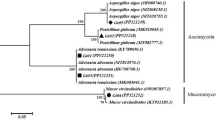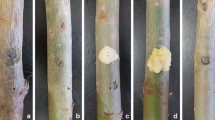Abstract
We identified two strains of endophytic bacteria associated with date palm explants by 16S rRNA gene amplification and sequencing, and we explored different approaches to control them. Based on their 16S sequences, the two isolates were identified as Microbacterium testaceum and Serratia marcescens. Antibacterial activity of essential oils, methanolic and aqueous extracts, from seven plant species against these endophytic bacteria was studied using different methods. The essential oils and the aqueous extracts of Artemisia herba-alba, Rosmarinus officinalis and Thymus satureioides inhibited the growth of both isolates through the disc diffusion method. The inhibition zones ranged from 18 to 31.5 mm and from 5 to 7 mm for essential oils and aqueous extracts, respectively. The minimum inhibitory concentration (MIC) and the minimum bacteriocidal concentration (MBC) values ranged from 0.025 to 0.033% and 0.033 to 0.05%, respectively. None of the methanolic extracts had any activity against the bacteria. The incorporation of the extracts into the culture medium showed different results depending on culture phase. During the induction phase, none of the extracts was able to inhibit the bacterial growth without causing phytotoxicity. During shoot bud multiplication, only the essential oils of A. herba-alba at the concentration of 0.1% inhibited the bacterial growth without causing phytotoxicity. Furthermore, the explants showed normal growth with an average number of 13.1 shoot buds per explant. The use of extract-impregnated plugs showed no inhibitory activity against the bacteria, whereas immersing explants in the antibacterial solutions caused browning and death of plant tissues.
Key message
The endophytic bacteria observed during date palm organogenesis and somatic embryogenesis were identified for the first time ever using 16S sequencing, and a new biological and efficient approach to control it was developed.


Similar content being viewed by others
References
Abahmane L (2011) Date palm micropropagation via organogenesis. In: Jain SM, Al-Khayri JM, Johnson DV (eds) Date palm biotechnology. Springer, Dordrecht, pp 69–90
Abdallah EM (2011) Plants: an alternative source for antimicrobials. J Appl Pharm Sci 1:16–20
Abd-El Kareim AHE (2009) Using actinomycetes on controlling bacterial contamination of date palm during different stages in vitro. J Hortic Sci Ornam Plants 1:92–99
Al-Dosary NH, Al-Mosaui MA, Al-Taha HA (2011) Isolation and identification of bacterial types that causes contamination of date palm Phoenix dactylifera L. callus and studying inhibitory activates of some plant extracts and antibiotic. Basra J Date Palm Res 10:68–81
Al-Mussawii MAY (2010) The source of bacterial contamination in date palm (Phoenix dactylifera L.) grown in vitro. Basra J Date Palm Res 9:132–146
Babu PD, Subhasree RS (2009) Antimicrobial ACTIVITIES of Lawsonia inermis—A review. Acad J Plant Sci 2(4):231–232
Benjama A, Charkaoui B (1997) Control of Bacillus contaminating date palm tissue in micropropagation using antibiotics. In: Cassells AC (ed) Pathogen and microbial management in micropropagation. Springer, Dordrecht, pp 207–211
Bittencourt MLF, Ribeiro PR, Franco RLP, Hilhorst HWM, de Castro RD, Fernandez LG (2015) Metabolite profiling, antioxidant and antibacterial activities of Brazilian propolis: use of correlation and multivariate analyses to identify potential bioactive compounds. Food Res Int 76:449–457
Celiktas OY, Kocabas EEH, Bedir E, Sukan FV, Ozek T, Baser KHC (2007) Antimicrobial activities of methanol extracts and essential oils of Rosmarinus officinalis, depending on location and seasonal variations. Food Chem 100:553–559
Charkaoui B (1997) Isolement, identification, et lutte contre les contaminations bactériennes en culture in vitro chez Phoenix dactylifera L. Thèse de Doctorat de 3ème cycle. Université Cadi Ayyad, Marrakesh, Morocco
De Sousa DP (2011) Analgesic-like activity of essential oils constituents. Molecules 16:2233–2252
Edris AE, Farrag ES (2003) Antifungal activity of peppermint and sweet basil essential oils and their major aroma constituents on some plant pathogenic fungi from the vapour phase. Nahrung/Food 47:117–121
El Asbahani A, Jilale A, Voisin SN, Aït Addi EH, Casabianca H, El Mousadik A, Hartmann DJ, Renaud FNR (2015) Chemical composition and antimicrobial activity of nine essential oils obtained by steam distillation of plants from the Souss-Massa region (Morocco). J Essent Oil Res 27:34–44
Gyaneshwar P, James EK, Mathan N, Reddy PM, Reinhold-Hurek B, Ladha JK (2001) Endophytic colonization of rice by a diazotrophic strain of Serratia marcescens. J Bacteriol 183:2634–2645
Inoue M, Craker LE (2014) Medicinal and aromatic plants-uses and functions. In: Dixon GR, Aldous DE (eds) Horticulture: plants for people and places volume 2. Springer, Dordrecht, pp 645–669
Jain SM (2011) Radiation-induced mutations for date palm improvement. In: Jain SM, Al-Khayri JM, Johnson DV (eds) Date palm biotechnology. Springer, Dordrecht, pp 271–286
Krueger RR (2011) Date palm germplasm. In: Jain SM, Al-Khayri JM, Johnson DV (eds) Date palm biotechnology. Springer, Dordrecht, pp 313–336
Krueger RR (2015) Date palm status and perspective in the United States. In: Al-Khayri JM, Jain SM, Johnson DV (eds) Date palm genetic resources and utilization volume 1: Africa and the Americas. Springer, Dordrecht, pp 447–485
Laborda R, Manzano I, Gamón M, Gavidia I, Pérez-Bermúdez P, Boluda R (2013) Effects of Rosmarinus officinalis and Salvia officinalis essential oils on Tetranychus urticae Koch (Acari: Tetranychidae). Ind Crop Prod 48:106–110
Leary JV, Nelso N, Tisserat B, Allingham EA (1986) Isolation of pathogenic Bacillus circulans from callus cultures and healthy offshoots of date palm (Phoenix dactylifera L.). Appl Envir Microbiol 52:1173–1176
Masmoudi-Allouche F, Meziou B, Kriaâ W, Gargouri-Bouzid R, Drira N (2011) In vitro flowering of date palm. In: Jain SM, Al-Khayri JM, Johnson DV (eds) Date palm biotechnology. Springer, Dordrecht, pp 585–604
Mazri MA (2014) Effects of plant growth regulators and carbon source on shoot proliferation and regeneration in date palm (Phoenix dactylifera L.) ‘16-bis’. J Hortic Sci Biotechnol 89:415–422
Mazri MA (2015) Role of cytokinins and physical state of the culture medium to improve in vitro shoot multiplication, rooting and acclimatization of date palm (Phoenix dactylifera L.) cv. Boufeggous. J Plant Biochem Biotechnol 24:268–275
Mazri MA, Meziani R (2013) An improved method for micropropagation and regeneration of date palm (Phoenix dactylifera L.). J Plant Biochem Biotechnol 22(2):176–184
Mazri MA, Meziani R (2015) Micropropagation of date palm: a review. Cell Dev Biol 4(3):160
Mazri MA, Meziani R, El Fadile J, Ezzinbi A (2016) Optimization of medium composition for in vitro shoot proliferation and growth of date palm cv. Mejhoul. 3 Biotech 6:111
Mazri MA, Belkoura I, Meziani R, Mokhless B, Nour S (2017) Somatic embryogenesis from bud and leaf explants of date palm (Phoenix dactylifera L.) cv. Najda. 3 Biotech 7:58
Mazri MA, Meziani R, Belkoura I, Mokhless B, Nour S (2018) A combined pathway of organogenesis and somatic embryogenesis for an efficient large-scale propagation in date palm (Phoenix dactylifera L.) cv. Mejhoul. 3 Biotech 8:215
Meziani R, Jaiti F, Mazri MA, Anjarne M, Ait Chitt M, El Fadile J, Alem C (2015) Effects of plant growth regulators and light intensity on the micropropagation of date palm (Phoenix dactylifera L.) cv. Mejhoul. J Crop Sci Biotechnol 18(5):325–331
Meziani R, Jaiti F, Mazri MA, Hassani A, Ben Salem S, Anjarne M, Ait Chitt M, Alem C (2016) Organogenesis of Phoenix dactylifera L. cv. Mejhoul: Influences of natural and synthetic compounds on tissue browning, and analysis of protein concentrations and peroxidase activity in explants. Sci Hortic 204:145–152
Morohoshi T, Wang WZ, Someya N, Ikeda T (2011) Genome sequence of Microbacterium testaceum StLB037, an N-acylhomoserine lactone-degrading bacterium isolated from potato leaves. J Bacteriol 193:2072–2073
Murashige T, Skoog FA (1962) A revised medium for rapid growth and bioassays with tobacco tissue cultures. Phys Planta 15:473–479
Najjaa H, Neffati M, Zouari S, Ammar E (2007) Essential oil composition and antibacterial activity of different extracts of Allium roseum L. North African endemic species. Comptes Rendus Chim 10:820–826
Ojaghian MR, Wang Q, Li X, Sun X, Xie G-L, Zhang JZ, Fan HW, Wang L (2016) Inhibitory effect and enzymatic analysis of E-cinnamaldehyde against sclerotinia carrot rot. Pestic Biochem Physiol 127:8–14
Ponce A, Fritz R, del Valle C, Roura S (2003) Antimicrobial activity of essential oils on the native microflora of organic Swiss chard. Food Sci Technol 36:679–684
Roohinejad S, Koubaa M, Barba FJ, Leong SY, Khelfa A, Greiner R, Chemat F (2018) Extraction methods of essential oils from herbs and spices. In: Hashemi SMB, Khaneghah AM, Sant’Ana AS (eds) Essential oils in food processing. IFT Press, Oxford, pp 21–55
Sedra MH (2011) Development of new Moroccan selected date palm varieties resistant to bayoud and of good fruit quality. In: Jain SM, Al-Khayri JM, Johnson DV (eds) Date palm biotechnology. Springer, Dordrecht, pp 513–531
Sedra MH (2015) Date palm status and perspective in Morocco. In: Al-Khayri JM, Jain SM, Johnson DV (eds) Date palm genetic resources and utilization volume 1: Africa and the Americas. Springer, Dordrecht, pp 257–323
Sedra MH, Lazrek BH (2011) Fusarium oxysporum f. sp. albedinis toxin characterization and use for selection of resistant date palm to bayoud disease. In: Jain SM, Al-Khayri JM, Johnson DV (eds) Date palm biotechnology. Springer, Dordrecht, pp 253–270
Shao X, Cheng S, Wang H, Yu D, Mungai C (2013) The possible mechanism of antifungal action of tea tree oil on Botrytis cinerea. J Appl Microbiol 114:1642–1649
Soylu EM, Yigitbas H, Tok FM, Soylu S, Kurt S, Baysal O, Kaya AD (2005) Chemical composition and antifungal activity of the essential oil of Artemisia annua L. against foliar and soil-borne fungal pathogens. Z Pflanzenk Pflanzen 112:229–239
Soylu EM, Kurt S, Soylu S (2010) In vitro and in vivo antifungal activities of the essential oils of various plants against tomato grey mould disease agent Botrytis cinerea. Int J Food Microbiol 143:183–189
Takeuchi T, Sawada H, Tanaka F, Matsuda I (1996) Phylogenetic analysis of Streptomyces spp. causing potato scab based on 16S rRNA sequences. Int J Syst Bacteriol 46:476–479
Tamura K, Peterson D, Peterson N, Stecher G, Nei M, Kumar S (2011) MEGA5: molecular evolutionary genetics analysis using maximum likelihood, evolutionary distance, and maximum parsimony methods. Mol Biol Evol 28:2731–2739
Tantaoui-Elaraki A, Lattaoui N, Errifi A, Benjilali B (1993) Composition and antimicrobial activity of the essential oils of Thymus broussonettii, T xygis and T satureioides. J Essent Oil Res 5:45–53
Viuda-Martos M, Mohamady MA, Fernández-López J, Abd El Razik KA, Omer EA, Pérez-Alvarez JA, Sendra E (2011) In vitro antioxidant and antibacterial activities of essentials oils obtained from Egyptian aromatic plants. Food Control 22:1715–1722
Yashphe J, Segal R, Breuer A, Erdreich-Naftali G (1979) Antibacterial activity of Artemisia herba-alba. J Pharm Sci 68(7):924–925
Acknowledgements
We are very grateful to Mr. Elmostafa El Fahime from the National Center for Scientific and Technical Research (CNRST, Rabat, Morocco) for his valuable assistance in 16S rRNA gene sequencing.
Author information
Authors and Affiliations
Contributions
RM, MAM, CA and FJ conceived and designed research. RM, HEI and ML prepared plant extracts and essential oils. RM, AE, HEI and ML performed antibacterial activity experiments. RM, MAM, HEI and ML performed organogenesis experiments. GD and FG performed DNA sequencing and bacteria identification. MAM and AE wrote the manuscript. MAM conducted statistical analysis. All authors read and approved the final manuscript.
Corresponding author
Ethics declarations
Conflict of interest
The authors declare that they have no conflict of interest.
Additional information
Communicated by Nokwanda Pearl Makunga.
Publisher’s Note
Springer Nature remains neutral with regard to jurisdictional claims in published maps and institutional affiliations.
Rights and permissions
About this article
Cite this article
Meziani, R., Mazri, M., Essarioui, A. et al. Towards a new approach of controlling endophytic bacteria associated with date palm explants using essential oils, aqueous and methanolic extracts from medicinal and aromatic plants. Plant Cell Tiss Organ Cult 137, 285–295 (2019). https://doi.org/10.1007/s11240-019-01570-1
Received:
Accepted:
Published:
Issue Date:
DOI: https://doi.org/10.1007/s11240-019-01570-1




